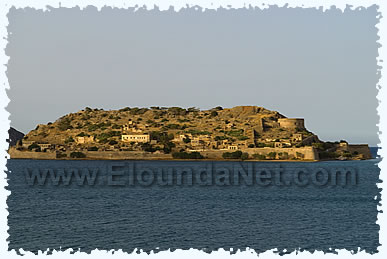 |
|
Home Page | Elounda Village | History | Places to Visit | News | Events' Calendar | Useful Information | Links | Contact |
|
| History of the area Ancient Olous
According to the narrations of various travelers of ancient times, we learn that the inhabitants had a social and professional level of development. From inscriptions that have been found, it is suggested that they were engaged in trade, with maritime affairs and in crushing shells to make colours and paints. They were also involved in the mining of whetting stones. Olous disappeared either because of a landslide or as result of the large earthquake of 780 A.D. Many ancient artifacts and inscriptions have been discovered from here, most of which are on display in the archaeological museum of Agios Nikolaos, or at The Louvre. Olous used to have its own currency. Sborous accounts for eleven different types of coins, most of them depicting Vritomaris Artemis on the one side, and Zeus as an eagle, dolphin or star on the other. The prosperity of Olounda continued on until the first Byzantine period. This fact is revealed by the church at Poros, with its great mosaic, which can be visited today, and by the church of kolokytha with its beautiful white marble. At Leroklis, (the Book of Sinekdinos), you can find Olous under the name of Aligos. Darkness, however, shrouds the following years between the ninth and thirteenth centuries.
Venetian period In 1210, the Venetians occupied the island. The first mention of the name Elounda is found on a document from 1376. The Venetians operated the salt mines, and under threat of danger from the Turks, rebuilt the fortress of Spinalonga in 1579. Many churches were erected during the latter Venetian occupation: Analipsis, Aghios Georgios in Katevati, the church of the Virgin Mary in Druvalia, Aghios Paraskevi in Tsifliki and Aghios Marinas in Plaka.
Turkish domination In 1669, the Turks captured the town of Handakas and became the rulers of Crete. Spinalonga would resist for 46 years more, until 1715 when the Turks took it. Here, revolutionaries found a refuge, and because of that event, the Turks forbade the expansion in the wider area of Spinalonga. This prohibition, as well as fear of pirates, caused the inhabitants who stayed in the small cattle settlements there to be extremely cautious. O regularized in the middle of the 18th century. We are informed by the traveler Pasley that in 1834, Elounda had 40 families, and that most of them came from Fourni. Elounda was burned down in 1823 by Hasan Pasha. The inhabitants played an active role in the revolt to overthrow the Turks, as did the cutting off of the fortress of Spinalonga. The contribution and sacrifices of the Eloundians for the liberation of Hirrus, Macedonia and Thrace were significant.
Spinalonga is an island fortress on the south western entrance to the Gulf of Elounda. It is 5.6km away from Skisma. On the rocky island of Spinalonga, a fortress was built even from ancient ages to protect the port of the ancient Eloundians. It is reported that many Christians from the surrounding village took refuge in the ruins to save themselves during the time that the Saracens overtook Crete. In 1579, the Venetian rulers built the most powerful fortress that we can admire today for the safety of the port of Elounda, to enclose the area at the entrance to every hostile ship. In 1630, the fortress seemed to be impregnable. In 1715, the Kapoudan Pasha, the Turkish captain, besieged it at close quarters and took it. During the 1821 Revolution, it was a safe haven for many Turks, and during the 19th century it was the main port which was importing and exporting goods fr the entire region of Mirambello. In 1881, it had 1112 Ottoman inhabitants who were involve in commerce, and they comprised the local council. During the revolution of 1821, 1866 and 1897, it was besieged by Cretan rebels. By decision of the State of Cretan, from 1904 Spinalonga was used as a gathering point and place of refuge for Cretans suffering from leprosy. For a half century, this barren rocky outcrop had been host to life’s outcasts who lived out a drama of human pain at the height of their tragedy. Here they found their life’s end as well as the paradise of their dreams. With the progress of science, a cure was found to put an end to the misery of these lepers, and the hospital was dissolved in 1957. Spinalonga is a recognized archaeological site, and constitutes an identified historical grouping, one of the few samples of the art of Venetian island fortification and fortress-building in the Eastern Mediterranean. Every year over 30000 Greek and foreign tourist visit this sight, from April through October.
Αρχαία Ολούς
Το διοικητικό σύστημα της Ολούντος ήταν η ευνομία, ένα είδος δημοκρατίας. Στην Ολούντα λατρευόταν ο Ταλλαίος Δίας, ο Απόλλωνας και η Βριτόμαρτις . Προς τιμήν τους γινόταν οι Ταλλαδίτες, γυμνικοί αγώνες και τα Βριτομάρτια. Επίσης λάτρευαν τον Ασκληπιό ο οποίος είχε σώσει την πόλη από μια άγνωστη επιδημία που είχε ταλαιπωρήσει τους κατοίκους. Από διηγήσεις διαφόρων περιηγητών της αρχαίας εποχής μαθαίνουμε ότι οι κάτοικοι της ήταν ανεπτυγμένου κοινωνικού και επαγγελματικού επιπέδου. Από τις επιγραφές που έχουν βρεθεί συμπεραίνουμε πως ασχολούνταν με το εμπόριο, τη θάλασσα και την επεξεργασία οστράκων από τα οποία έβγαζαν χρώματα και βαφές. Ακόμα έκαναν εξόρυξη ακονόπετρας. Η Ολούς αφανίστηκε είτε από τοπική καθίζηση, είτε από το μεγάλο σεισμό του 780 μ.Χ. Έχουν βρεθεί πολλά αρχαιολογικά ευρήματα και επιγραφές τα περισσότερα από τα οποία βρίσκονται στο αρχαιολογικό μουσείο του Αγίου Νικολάου και του Λούβρου. Η ακμή της Ολούντας συνεχίστηκε και κατά την πρώτη Βυζαντινή περίοδο. Το μαρτυρούν η Βασιλική του Πόρου με το θαυμάσιο μωσαϊκό και η Βασιλική της Κολοκύθας με τα εξαίσια λευκά μάρμαρα.
Ενετική περίοδος Το 1210 το νησί καταλαμβάνουν οι Ενετοί. Πρώτη μνεία του ονόματος Ελούντα έχουμε σε ένα έγγραφο του1376. Οι Ενετοί φτιάχνουν αλυκές για την παραγωγή αλατιού και υπό την απειλή του τουρκικού κινδύνου αρχίζουν το 1579 την ανοικοδόμηση του φρουρίου της Σπιναλόγκας.
Τουρκοκρατία Το 1669 οι τούρκοι καταλαμβάνουν το Χάνδακα και γίνονται κυρίαρχοι της Κρήτης. Η Σπιναλόγκα θα αντισταθεί για 46 χρόνια ακόμη. Μέχρι το 1715 που την κατέλαβαν οι τούρκοι έβρισκαν σ΄ αυτήν καταφύγιο οι επαναστάτες. Eξ αιτίας αυτού του γεγονότος οι τούρκοι είχαν απαγορεύσει την εγκατάσταση σε όλο τον ευρύτερο χώρο της Σπιναλόγκας. Η απαγόρευση αυτή και ο φόβος των πειρατών κάνουν επιφυλακτικούς τους κατοίκους που μένουν σε μικρούς κτηνοτροφικούς οικισμούς μακριά από τη θάλασσα. Η κατοίκηση των οικισμών (Πάνω, Κάτω Ελούντας και Μαυρικιανό) σε μόνιμη βάση άρχισε από τα μέσα του 18ου αιώνα. Το 1834 όπως μας πληροφορεί ο περιηγητής Πάσλεϋ η Ελούντα έχει 40 οικογένειες οι περισσότερες από τις οποίες προέρχονται από τη Φουρνή. Η Ελούντα κάηκε το1823 από τον Χασάν πασά. Οι κάτοικοι πήραν ενεργό μέρος σε όλες τις επαναστάσεις για την αποτίναξη του τουρκικού ζυγού, καθώς και στους αποκλεισμούς του φρουρίου της Σπιναλόγκας. Σημαντική ήταν η προσφορά και οι θυσίες των Ελουντιανών για την απελευθέρωση της Ηπείρου, της Μακεδονίας και της Θράκης.
Σπιναλόγκα Tο πιο γνωστό νησί της Kρήτης, βράχος και φρούριο στη B.Δ. είσοδο της λιμνοθάλασσας της Eλούντας. Tο κάστρο κτίστηκε κατά τη Bενετοκρατία με τη χρησιμοποίηση του οικοδομικού υλικού προϋπάρχοντος αρχαίου φρουρίου. Θεμελιώθηκε το 1579 από το Bενετό προβλεπτή Luca Michiel, όπως αναγράφεται στο ανώφλι της κύριας εισόδου, στα πλαίσια της προσπάθειας των Bενετών να οργανώσουν το αμυντικό σύστημα της Kρήτης προκειμένου να αντιμετωπίσουν τον Tουρκικό επεκτατισμό και τις πειρατικές επιδρομές. Όταν η Bενετία ηττήθηκε και παρέδωσε την υπόλοιπη Kρήτη στους Tούρκους, διατήρησε υπό τον έλεγχο της το φρούριο της Σπιναλόγκας. Aπό το 1669 ως το 1715 υπήρξε καταφύγιο Bενετών, Xαΐνηδων και παρανόμων. Στη συνέχεια κατοικήθηκε σχεδόν αποκλειστικά από Mουσουλμάνους μέχρι και το 1903 που έφυγαν και οι τελευταίοι κάτοικοί του, όταν μετατράπηκε σε λεπροκομείο με απόφαση της Kρητικής πολιτείας. Tο 1957 σταμάτησε η λειτουργία του και από τότε παραμένει ακατοίκητο. Πρόσφατα όμως ξεκίνησε η αναστήλωση των κτισμάτων. Tα δημόσια κτίρια, οι κατοικίες και τα τείχη που αναστηλώνονται, ανασυνθέτουν την ιστορία του νησιού και μεταδίδουν την ένταση των περιπετειών του. Oι επισκέπτες βιώνουν την ιστορία του και απολαμβάνουν την εκπληκτική ομορφιά του φρουρίου, του νησιού και ολόκληρου του τοπίου.
|
|

